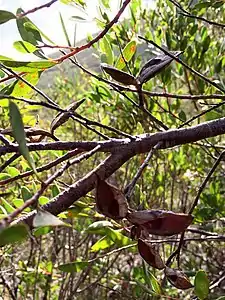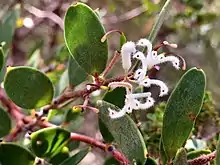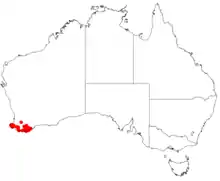Hakea lasiantha
Hakea lasiantha, commonly known as the woolly-flowered hakea,[2] is a shrub in the family Proteacea endemic to an area along the south coast in the South West and Great Southern regions of Western Australia.[3]

| Hakea lasiantha | |
|---|---|
 | |
| Hakea lasiantha in the Stirling Range National Park | |
| Scientific classification | |
| Kingdom: | Plantae |
| Clade: | Tracheophytes |
| Clade: | Angiosperms |
| Clade: | Eudicots |
| Order: | Proteales |
| Family: | Proteaceae |
| Genus: | Hakea |
| Species: | H. lasiantha |
| Binomial name | |
| Hakea lasiantha | |
 | |
| Occurrence data from AVH | |
Description
The erect non-lignotuberous dense rounded shrub typically grows to a height of 0.6 to 3 metres (2 to 10 ft). It blooms from May to September and produces white flowers and have woolly white or yellowish brown perianths with a deep red style in clusters in the leaf axils. The leaves are flat, elliptic or obovate, about 3–6 cm (1–2 in) long by 0.7 cm (0.3 in) young leaves and branchlets are clothed in rusty-woolly hairs. The smooth narrowly elliptic fruit are normally 2.5–3 cm (1 inch) long and only a slight beak.[4][2]
Taxonomy and naming
Hakea lasiantha was first formally described by Scottish botanist Robert Brown in 1830.[3] The specific name is derived from ancient Greek words lasios (λάσιος) meaning "shaggy" and anthos (ἄνθος) meaning flower,[5][6] referring to the woolly flower structure.[4]
Distribution and habitat
This species prefers low lying wet depressions from the Stirling Range to Albany and along the coast to Ravensthorpe. Grows on sandy loam and gravel in heath and scrubland. It prefers a well-drained site with a sunny aspect and withstands salt laden winds. A good shade tree and windbreak that tolerates frost.[2][4]
Conservation status
Hakea lasiantha is classified as "not threatened" by the Western Australian Government.[3]
References
- "Hakea lasiantha". Australian Plant Census. Retrieved 30 December 2019.
- Holliday, Ivan (2005). Hakeas: A Field and Garden Guide. Reed New Holland. ISBN 1-877069-14-0.
- "Hakea lasiantha". FloraBase. Western Australian Government Department of Biodiversity, Conservation and Attractions.
- Young, J A. Hakeas of Western Australia: A Field and Identification Guide. J A Young. ISBN 0-9585778-2-X.
- Francis Aubie Sharr (2019). Western Australian Plant Names and their Meanings. Kardinya, Western Australia: Four Gables Press. p. 313. ISBN 9780958034180.
- Backer, C.A. (1936). Verklarend woordenboek der wetenschappelijke namen van de in Nederland en Nederlandsch-Indië in het wild groeiende en in tuinen en parken gekweekte varens en hoogere planten (Edition Nicoline van der Sijs).